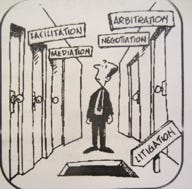Best Case Scenario: Cheaper, Deeper, Faster, Better Solutions
TRANSCEND MEMBERS, 6 Jun 2022
Diane Perlman, Ph.D. | Substack - TRANSCEND Media Service
www.bestcasescenario.solutions
A Court-Free Alternative for Reparative and Transformational Justice
31 May 2022 – Our current legal system has a grip on virtually every aspect of life. As we emerge from our collective ordeal to recreate our new, improved society, let’s design an enlightened system that optimizes outcomes for all parties while addressing underlying causes and systems that lead to conflicts to heal the web of society.
Once a conflict enters the legal system, it takes on a life of its own, becoming unnecessarily stressful, costly, and time-consuming. toxic, abusive and traumatic. It is unaffordable to some who helplessly have no other redress and just get screwed.
The system is more about rules than truth or justice. It can consume years and ruin lives, health, careers, and fortunes.
Structurally, the legal system is dualistic, adversarial, and superficial. While mediation and alternative dispute resolution (ADR) may be an improvement, even the best mediators are embedded in an elaborate system of rules that restrict what is possible.
Rules may not allow for truth, justice or problem-solving strategies beyond compromise or pressure. They don’t account for inequity, structural violence or tender emotions at play like guilt, shame, humiliation, trauma, fear, the need to save face and reduce fears of retaliation.
Even for those who “win,” the process itself causes stress, harm, and misses the opportunity and learning experience of wise, healing approaches to human problems.
The system is not set up to explore potential win-win, nonzero sum outcomes optimized for all parties. It is not creative and rarely involves relationship experts trained in the healing arts. Imagine conflicts being resolved in a few sessions with professionals trained in conflict transformation, free from the constraints and rules of the legal system.
The legal/court process is like cutting butter with a chainsaw, except you cut through the plate, table and splatter the butter and don’t even get to eat it.
There exists knowledge and practice to inform a new system of reparative justice that endeavors to benefit society as a whole while saving many individuals from the scourges of unwanted, unnecessary, toxic, costly, traumatic litigation and legal abuse.
Practices such as collaborative divorce, victim-offender mediation, and community mediation exist in isolated fragmented form. We can build a robust, coherent, integrated, system of reparative justice.
Ho’o Pono Pono
There are optimal, healthy ways to resolve and transform conflicts, an inevitable part of life. There is no such thing as “conflict prevention.” Wisely working through conflicts produces personal growth and contributes to conscious evolution. For any conflict, we can imagine a “Best Case Scenario,” the most optimal outcome for all parties.
Ancient rituals in various cultures are designed to heal individuals and the social fabric from which a conflict arises. A favorite among my friends and colleagues in Transcend International, (transcend.org) is the ancient Hawaiian ritual and sound practice known as Ho’o Pono Pono, meaning “setting things right, very right.”
I recall the example I learned from my friend and mentor Johan Galtung, founder of Transcend, international. An old wealthy man is awakened by noise of a burglary and calls the police. The youth who works for him stole $10. Realizing that a delinquent identity may set the boy’s life’s path., the man tells the police, “Let me handle this with ho’o ponopono” an alternative that exists in Hawaii.
It turns out that the boy’s sister is diabetic and the family could not afford the medication. The father was unemployed and alcoholic and the mother was depressed.
A wise person, WP is designated to understand the conflict from the perspective of each family member and neighbor, considering acts of both commission and omission, including failure to prevent the problem.
The boy apologized, as did others in the system who failed to prevent this. The boy repaid the man by doing garden work. The wealthy man and community contributed to the family’s medical expenses – treatment for the parents and medicine for the sister – thus addressing the underlying causes and healing the entire system.
Johan Galtung further analyzes –
All acts of omission have to be turned into acts of commission for a better community.
The record of the burglary is burnt, symbolizing the end to that conflict. But not to the healing of the community. WP sees to it that they keep the promise to do the good they failed to do; restoring the community, reconciling them, resolving the conflict.
It may all sound simple, but is not. This approach requires deep knowledge and skills from a conflict-peace worker, in choosing the participants and being the wise person chairing the session. No approach has so many reconciliation elements as this one.
- There is the exculpatory element, the deficient community.
- There is reparation-restitution, as unpaid gardener
- There is apology to the victim and the community.
- There is penitence for acts of commission and omission.
- There is punishment in the free work as gardener.
- There is joint karma in the ho’o ponopono circle itself.
- There is history-truth in the multiple perspectives given.
- There is theater-reliving, constructing an alternative future.
- There is joint sorrow in the apologies to the community.
- There is joint reconstruction-structuration of the community.
- There is joint resolution of the damage, bills are paid.
From Reconciliation Clearing the Past, Building a Future, by Joanna Santa Barbara, Johan Galtung and Diane Perlman
Best Case Scenario.Solutions (BCSS)
There exist many mediation groups and practices, mostly embedded in the legal system. A pioneering project can create a court-free model of collaborative practice to provide a vigorous, sound, affordable (sliding scale, not taking years), attractive alternative independent from the legal system.
This approach can be akin to having the choice of integrative, complementary and functional medicine. Let’s create a Reparative and Transformational Justice alternative system, an accessible, collaborative practice network that uses amicable, creative, nonzero, problem-solving practices capable of transforming conflicts in a way that is cheaper, deeper, faster and produces far better outcomes outside of court.
A collaborative interdisciplinary professional network is led by relationship experts in the healing arts– psychologists, social workers, mediators, collaborating with lawyers and financial experts and others as needed, working in teams.
A network would include a range of professionals qualified to address conflicts involving family conflicts, divorce, custody, eldercare, landlord – tenant, owner – HOA, victim – offender, toxic torts, small business, helping juveniles build a life out of the penal system, and any kind of disputes that may arise. An intake of each case will inform selection of appropriate professionals to compose a team best qualified to address each situation.
Years ago, I optimistically reserved the domain name www.BestCaseScenario.Solutions
This alternative can be made available to the general public, previously with no other options who are involuntarily driven down a path they would never have chosen.
Correcting and transforming underlying conflicts and addressing sources of problems will benefit society greatly in addition to helping individuals and freeing them up to live productive lives rather than being dragged through stressful, sometimes unfair litigation which can rob people of quality of life and fortune – often ruining lives.
“You never change things by fighting the existing reality. To change
something, build a new model that makes the existing model obsolete.”
—Buckminster Fuller
_____________________________________________
 Diane Perlman, PhD is a clinical and political psychologist, devoted to applying knowledge from psychology, conflict studies and social sciences to designing strategies and policies to reverse nuclear proliferation, to drastically reduce terrorism, reduce enmity, and to raise consciousness about nonviolent strategies for tension reduction and conflict transformation. She is a visiting scholar at the School for Conflict Analysis and Resolution at George Mason University, is active in Psychologists for Social Responsibility, the TRANSCEND Network for Peace Development Environment, and on the Global Council of Abolition 2000. Some of her writings can be found on her websites, www.consciouspolitics.org and www.SanityandSurvival.com. Email: dianeperlman@gmail.com
Diane Perlman, PhD is a clinical and political psychologist, devoted to applying knowledge from psychology, conflict studies and social sciences to designing strategies and policies to reverse nuclear proliferation, to drastically reduce terrorism, reduce enmity, and to raise consciousness about nonviolent strategies for tension reduction and conflict transformation. She is a visiting scholar at the School for Conflict Analysis and Resolution at George Mason University, is active in Psychologists for Social Responsibility, the TRANSCEND Network for Peace Development Environment, and on the Global Council of Abolition 2000. Some of her writings can be found on her websites, www.consciouspolitics.org and www.SanityandSurvival.com. Email: dianeperlman@gmail.com
Go to Original – coronawise.substack.com
Tags: Conflict Mediation, Conflict Resolution, Conflict Transformation, Conflict studies, Legality, Restorative Justice, Transitional Justice
DISCLAIMER: The statements, views and opinions expressed in pieces republished here are solely those of the authors and do not necessarily represent those of TMS. In accordance with title 17 U.S.C. section 107, this material is distributed without profit to those who have expressed a prior interest in receiving the included information for research and educational purposes. TMS has no affiliation whatsoever with the originator of this article nor is TMS endorsed or sponsored by the originator. “GO TO ORIGINAL” links are provided as a convenience to our readers and allow for verification of authenticity. However, as originating pages are often updated by their originating host sites, the versions posted may not match the versions our readers view when clicking the “GO TO ORIGINAL” links. This site contains copyrighted material the use of which has not always been specifically authorized by the copyright owner. We are making such material available in our efforts to advance understanding of environmental, political, human rights, economic, democracy, scientific, and social justice issues, etc. We believe this constitutes a ‘fair use’ of any such copyrighted material as provided for in section 107 of the US Copyright Law. In accordance with Title 17 U.S.C. Section 107, the material on this site is distributed without profit to those who have expressed a prior interest in receiving the included information for research and educational purposes. For more information go to: http://www.law.cornell.edu/uscode/17/107.shtml. If you wish to use copyrighted material from this site for purposes of your own that go beyond ‘fair use’, you must obtain permission from the copyright owner.
